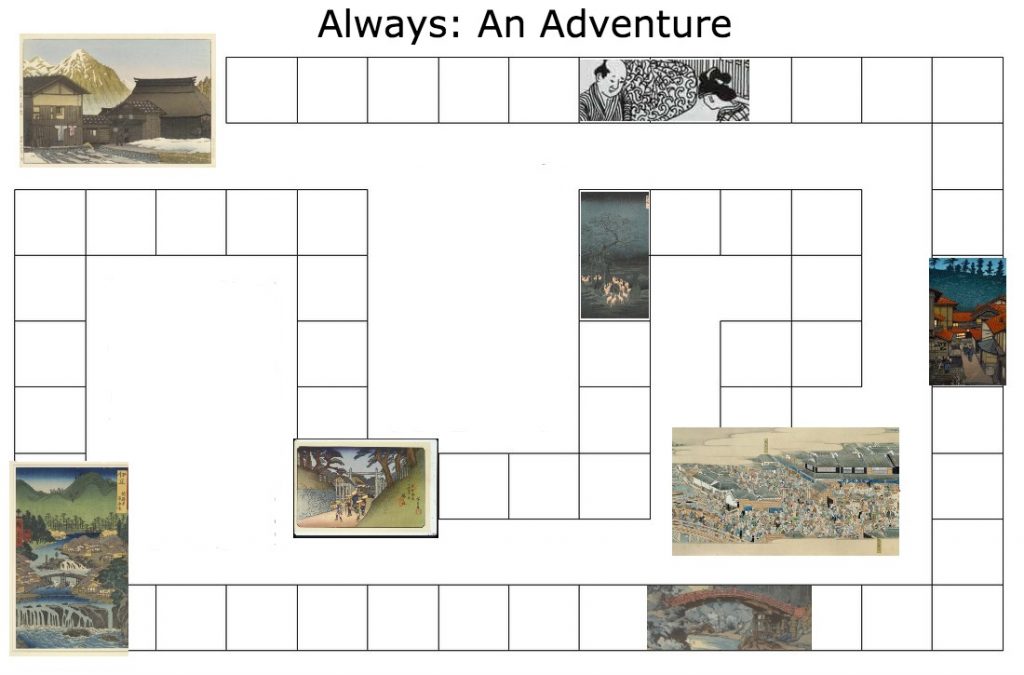
BACKGROUND
Tsuneno’s adventure begins in 19th century Japan where she explores the world unconventionally while going through hardships that include relationships, money and trying to achieve her goal of reaching Edo, which is a destination she had longed to visit. Over the duration of two weeks, she encountered treacherous mountain treks and situations that were difficult for her to dispute; she held a positive mindset and claimed that it was worth the journey. Tsuneno was someone that was crafty and always dealt with harsh circumstances the best way that she could during a time where “most ordinary women spent their lives working and breeding and, […] died at an early age, without having given any more thought to material independence or cultural enjoyments than to the possibility of visiting the moon” (Nenzi, p. 73).
Tsuneno’s story is one of uncertainty and brings readers through a plethora of emotions. Amy Stanley writes Tsuneno’s expedition in great detail, bringing the readers into her world and enabling them to picture the route and scenic sites that she discovers. This game will include the famous places that Tsuneno comes across and the experiences that she encounters.
INSTRUCTIONS
The player will roll the dice and move forward the number shown on the dice. After rolling the dice, if the player stops at a blank space, no actions are needed, and the next player will go. If the player stops on a block with a picture, they must roll the dice again. If they roll a “4”, there is a consequence according to the image, and they must move back a spot. If they roll an “8,” they are rewarded and may move forward one spot. If they roll the dice and it is not any of those two numbers, the player stays in that spot.
dice link: https://www.teacherled.com/iresources/tools/dice/ (use two dice)
CONSEQUENCES
The first picture on the board represents the time Tsuneno arrives at Iimuro village, where she had to sell belongings from her trousseau to prepare for her journey, but “the value of clothing was unstable and difficult to measure” (Stanley, p. 176). If the player rolls an “8”, that means that the man showed interest in her items, and the player may move up a spot. If they roll a “4,” the man did not feel there was any value in what she was offering, and they must move back a spot.
The second image is when she sets off on foot to Takada, and the consequences vary depending on the number rolled. A “4” would mean that her brother sees her in Takada, and her journey is now delayed. An “8” means she successfully uses her trip as an excuse to start her journey to Edo.
The following picture is of the Shimogomachi bridge where she meets Chikan, who wants to go to Edo as well. If the player rolls and gets a “4,” that means that Tsuneno is unsure about continuing on the journey with Chikan and has to think about it for a few days, therefore, having to move back a spot, delaying the trip. If the player rolls an “8,” that means Tsuneno is excited to have a travel companion and does not need to spend money on an escort.
The image after the bridge is of Akakura, where Tsuneno stays a few nights to prepare for her journey. A “4” consequences in the player needing to rest for a bit and staying a few nights, delaying the journey further and therefore having to move back a spot. A reward would be that Tsuneno was brave enough to admit to her family that she is going to Edo, and because of her courage, she was able to move forward.
The next stop is at the Sekikawa Barrier, a checkpoint along the road where samurais check travel passes. Rolling a “4” means Tsuneno gets refused because she does not have the necessary documents. An “8” leads to her leaving the highway to avoid the checkpoint, thus being able to continue the journey but needing to hire a guide for a few dozen copper coins.
The stop after the Sekikawa barrier is the Hackberry tree, a “tie-cutting” tree with shrines beside it. A “4” would mean that she remembers the family that she has cut ties with and feels a bit emotional. Thus, the player must move back because Tsuneno ponders whether the sacrifices she had to make this far were worth it. If the player rolls an “8,” she reminisces and thinks about her family but sees it as motivation to continue her journey to finally archive happiness.
The last stop is Edo. Whoever reaches here first is the winner of the entire game!
SOURCES
Nenzi, Laura. Excursions in Identity: Travel and the Intersection of Place, Gender, and Status in Edo Japan. University of Hawai’i Press, 2008. muse.jhu.edu/book/8261.
Stanley, Amy. “Fashioning the Family: A Temple, a Daughter, and a Wardrobe.” Essay. In What Is a Family?: Answers from Early Modern Japan, edited by Mary Elizabeth Berry and Marcia Yonemoto, 174–94. University of California Press, 2019. http://www.jstor.org/stable/j.ctvr7fdd1.1.
———. Stranger in the Shogun’s City: A Japanese Woman and Her World. London: Scribner, 2020. https://ebookcentral.proquest.com/lib/ubc/detail.action?docID=6235968.